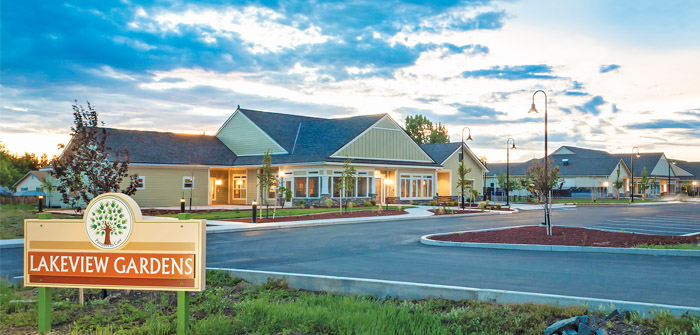(Photo above, Lakeview Gardens Independent and Assisted Living Community, Lakeview, Oregon, Courtesy of Cheryl McIntosh)
Good news…we’re living longer. The average American can expect to live more than 78 years according to a study by the National Center for Health Statics. The bad news? Seniors are facing significant health care issues. The leading cause of death for people 65 and older is heart disease, cancer and chronic lower respiratory disease. Nearly 40 percent of Americans between 65-74 years of age are obese. Only about 12 percent of people over 65 said they spend time exercising. All these statistics point to a sedative, isolated lifestyle. So what type of living environments can help seniors thrive? One that feels like home, is safe and provides seniors with independence and dignity. Lakeview Gardens is taking a different approach to senior living in their south-central Oregon community with a new cottage modeled project. Transitioning away from an institutional, one-size-fits-all philosophy these two cottages are moving towards “person-directed care” that emphasizes a meaningful life for residents, empowers staff and replicates the feeling of home. This new approach manifests in both operations and design. Here is how it works.
Make it Feel Like Home with Safety Built In
A senior living community designed at a residential scale provides a feeling of home and includes features that help seniors live safely as they age. For example, Lakeview Gardens in Lakeview, Oregon contains two 7,500 sq. ft. cottages (one independent living and the other assisted living) and includes 12 bedrooms and community space. Each person has a private bedroom and bathroom that opens to a central Hearth Room (aka living room) with an open kitchen and dining room. The private bedrooms are equipped with lifts, so residents can continue to age in place as their mobility declines. The exterior and interior replicate a single-family home with residential, non-institutional furnishings and décor. The cottages may look and feel like a family home, but additional attention was put into the design to ensure safety for the staff and residents.
According to a study by the National Center for Assisted Living, falls are the leading cause of both fatal and nonfatal injuries for adults 65 and older. Smooth flooring transitions that are durable and aesthetically pleasing plus handrails that define the accented walls and aid residents when needed help to reduce falls. Clear sight lines through much of the building due to the open floor plan allow staff to see residents in multiple spaces.
Provide Seniors Independence and Dignity
After being self-sufficient for 60-70+ years, seniors don’t want to be told what to do and when. They also don’t want everything to be done for them. Adapting to increased dependence is challenging for both the aging adult and their caretakers. Upon admission, residents are asked specific questions about their lives to create the best routine and level of support for each resident. The layout of the individual cottages encourages residents to assist with cooking, cleaning and daily operations to facilitate independence and self-worth. Meals are prepared in the community kitchen. Residents are encouraged to help with cooking meals, baking snacks and setting the table just as they would in their own homes. Meal times are flexible allowing residents to eat with the group or on their own if they decide.
Providing opportunities for independence and purpose are essential to the health and well-being of aging adults. Studies show 15 percent of women and ten percent of men over 65 report symptoms of depression with those percentages increasing with age. Depression leads to additional health concerns. If residents can decide on where and when they would like to spend their time and how much or how little they would like to participate in daily activities it can preserve their sense of dignity. Having private bedrooms for solitude and group gathering areas for socializing also encourages independence. Although there is a regular schedule of activities, the residents of Lakeview Garden dictate their day and work with the staff together as a household. Staff becomes more like friends and family; working together in all parts of the senior’s life.
Thinking outside the typical senior living box can help all of us lead more extended, more enjoyable lives. Living in an environment that supports aging adults and encourages an active lifestyle also reduces healthcare costs across the board. A win, win situation.
Briana Manfrass is an associate principal and interior designer with Pinnacle Architecture. Manfrass earned an Evidence Based Design Accreditation and Certification (EDAC) from The Center for Health Design whose mission is to transform healthcare environments through design research, education and advocacy. She’s successfully applied her knowledge to a variety of project types from healthcare to senior living facilities including her most recent project Lakeview Gardens, a unique assisted living community in Lakeview, OR. Manfrass has presented at Leading Age in Redmond and Environments for Aging in Austin, Texas. Manfrass can be reached at Briana@parch.biz or 541-388-9897



